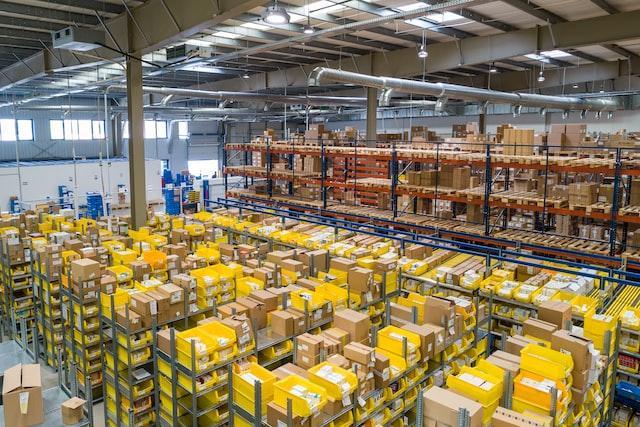To run a successful business, you need to have an efficient warehouse. This is important in order to process orders quickly and accurately. It also helps you save money on costs such as labor and storage space.
A good warehouse management system can help you streamline your operations so that these goals are easier to achieve. In this article, we will discuss some of the best tools for managing your warehouse at a high level of efficiency.
Organized storage
It’s important to understand that having an organized warehouse is one of the most crucial factors in ensuring efficiency. When you have a plan in place, your team will be able to find and retrieve items efficiently, which will save time and money. To begin planning, think about what needs to be stored and where it should go.
For example: do you want your inventory divided by product category or by brand? Are there specific types of tools that need their own dedicated storage area? Do certain items require more protection than others (for example, wooden pallets are more prone to damage than plastic ones)? Once you know what needs storing in your warehouse space, create some individualized plans for each section based on its requirements.
Read More
Functions of A Warehouse Management System
Automated storage and retrieval systems
Automated storage and retrieval systems are automated machines that can be programmed to store, retrieve and move items. They’re designed for use in warehouses, factories and distribution centers where manual labor is required for handling heavy or bulky materials.
Automated storage and retrieval systems consist of multiple cranes that are linked together by a network of conveyors. The cranes can be programmed to move automatically along the conveyor system to pick up pallets of goods and then return them to their designated locations. This allows workers at each location to focus on other tasks instead of having to manually pick up each pallet individually.
Workflow Scheduling
This feature helps you know when workers should be working on certain tasks so that everything gets done efficiently. If a worker is scheduled for too many tasks at once, it can create bottlenecks for other workers who depend on them for assistance with their own tasks. Scheduling also makes sure that all workers complete their tasks within a reasonable timeframe so that there’s minimal downtime between shifts and the overall workflow continues without interruption or delay.
Wireless warehouse operations
Wireless warehouse operations are a great way to improve efficiency. They can also reduce errors, increase safety and improve communication between workers and managers.
For example, the wireless devices used in the warehouse allow for real-time data collection and analysis. This means that managers can see how many pallets are on the floor at any given time, as well as how many units of each product were received or shipped out in a specific period of time. This will allow them to determine if they need more personnel or equipment in order to meet their goals faster than ever before!
Palletizers
Palletizers use a forklift, conveyor belt, or both to stack boxes on pallets. They can either be manual or automated; if you have a large warehouse with many employees and equipment to help you move your products around, then it may make sense for you to invest in an automated system.
If you’re interested in using palletizers but don’t want to spend money on an automatic one yet (which is understandable), then consider using a manual system that allows people with different skill sets (such as forklift operators) to customize how they stack their boxes. By doing this, workers can work more efficiently without having a machine telling them where and how fast they should move around the warehouse—and this flexibility means that everyone will be able to work at their optimal pace without feeling pressured by technology.
Shrink Wrapping Equipment
Shrink wrapping is a plastic film that is wrapped around products to protect them from dirt, dust and moisture. The film shrinks when heat is applied and this creates an airtight seal on the product. This can be used as a great way to protect your products from damage and theft while they are sitting in storage or being transported.
Shrink wrap can also be used to package your products for shipping if you’re selling online or in stores.
Conveyor belt rollers
Conveyor belt rollers are an essential tool that can help you to have an efficient warehouse. Conveyor belts are used to move items around the warehouse and conveyor belt rollers are used to help move those items along the conveyor belts. These conveyor belt rollers can be used for automation and efficiency, allowing your staff members to focus on other tasks while they’re working on moving items through the warehouse.
Conveyor belt rollers come in different sizes depending on how much weight they need to carry and how fast or slow you want them to go. Conveyor belts are made of rubber or plastic which makes them durable enough for any type of work environment, including warehouses where there may be heavy equipment being moved around frequently throughout each day.
Real-time data
Real-time data is useful for tracking inventory and shipments. Real-time data can be used to track the progress of a delivery or order.
Real-time data can be used to track the individual location of each product as it moves from one place to another, creating an accurate record of its movement through your warehouse over time. Real-time outbound shipping information helps you stay up-to-date on when a shipment leaves your facility, what route it takes and when it should arrive at its destination.
To be cost efficient, the warehouse needs to hold and move the right products at the right time, so optimization is crucial. This leads to an enormous amount of details that need to be managed in order to keep costs low and reduce waste.



